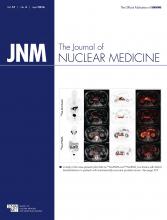Abstract
Our objective was to compare 18F-FDG PET/MRI (performed using a contrast-enhanced T1-weighted fat-suppressed volume-interpolated breath-hold examination [VIBE]) with 18F-FDG PET/CT for detecting and characterizing lung lesions in oncologic patients. Methods: In 121 oncologic patients with 241 lung lesions, PET/MRI was performed after PET/CT in a single-injection protocol (260 ± 58 MBq of 18F-FDG). The detection rates were computed for MRI, the PET component of PET/CT, and the PET component of PET/MRI in relation to the CT component of PET/CT. Wilcoxon testing was used to assess differences in lesion contrast (4-point scale) and size between morphologic datasets and differences in image quality (4-point scale), SUVmean, SUVmax, and characterization (benign/malignant) between PET/MRI and PET/CT. Correlation was determined using the Pearson coefficient (r) for SUV and size and the Spearman rank coefficient (ρ) for contrast. Results: The detection rates for MRI, the PET component of PET/CT, and the PET component of PET/MRI were 66.8%, 42.7%, and 42.3%, respectively. There was a strong correlation in size (r = 0.98) and SUV (r = 0.91) and a moderate correlation in contrast (ρ = 0.48). Image quality was better for PET/CT than for PET/MRI (P < 0.001). Lesion measurements were smaller for MRI than for CT (P < 0.001). SUVmax and SUVmean were significantly higher for PET/MRI than for PET/CT (P < 0.001 each). There was no significant difference in lesion contrast (P = 0.11) or characterization (P = 0.076). Conclusion: In the detection and characterization of lung lesions 10 mm or larger, 18F-FDG PET/MRI and 18F-FDG PET/CT perform comparably. Lesion size, SUV and characterization correlate strongly between the two modalities. However, the overall detection rate of PET/MRI remains inferior to that of PET/CT because of the limited ability of MRI to detect lesions smaller than 10 mm. Thus, thoracic staging with PET/MRI bears a risk of missing small lung metastases.
Footnotes
Published online Jan. 7, 2016.
- © 2016 by the Society of Nuclear Medicine and Molecular Imaging, Inc.







